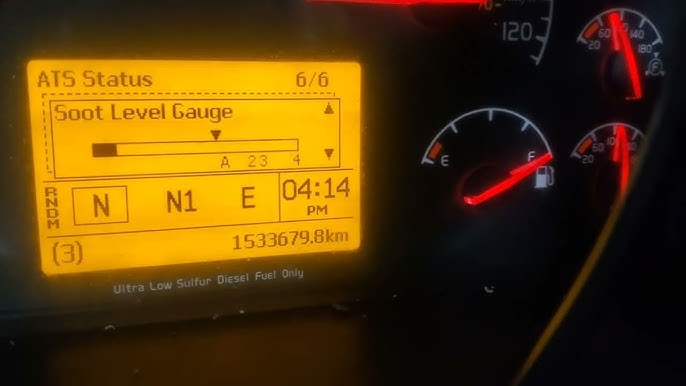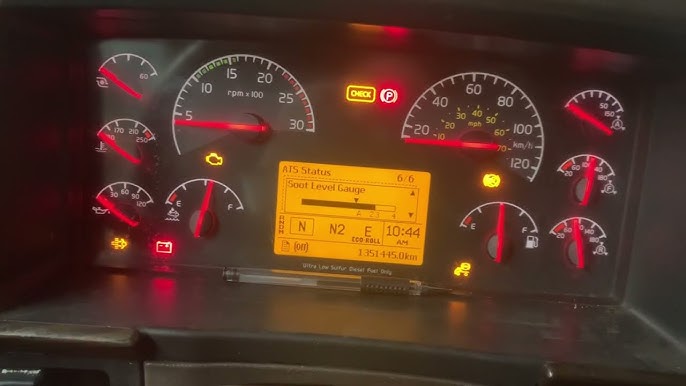Volvo vehicles with diesel engines have a soot level gauge to monitor the amount of particulate matter in the exhaust system. What is soot level gauge Volvo?
When a diesel engine burns fuel, it emits exhaust gases containing small particles of soot and carbon. These particles accumulate in the diesel particulate filter (DPF) of the vehicle over time. The soot level gauge serves as a monitoring system, displaying the current amount of particulate buildup in the DPF to the driver. The gauge helps determine when the filter needs to be cleaned by keeping track of the soot levels, either through a vehicle regenerated process or filter replacement. Monitoring soot levels is critical for ensuring that the DPF continues to filter exhaust emissions from the vehicle.

Contents
What Is Soot Level Gauge Volvo?
The soot level gauge is a vital monitoring system found on Volvo vehicles with diesel engines. These engines emit exhaust gases containing small particulates composed of soot and carbon. Volvos use a diesel particulate filter (DPF) as part of the exhaust system to capture these emissions. Soot and other particles accumulate in the DPF over time.
The soot level gauge is useful in this situation. It gives drivers an indication of the amount of particulate matter that is presently kept in the DPF. The gauge, which usually shows as a percentage, shows how much filtration capacity is left. A 50% reading, for instance, indicates that half of the soot has been trapped in the filter. This method of soot level monitoring aids in determining when the DPF needs to be regenerated.
In the regeneration process, soot that has become trapped inside the DPF is burned off by raising exhaust temperatures. A blockage in the filter may result from excessive particulate matter. Performance related to emissions is harmed by this. Volvo drivers can keep up with DPF maintenance by monitoring the soot level indicator.
They understand when regeneration is required or when the filter needs to be replaced as it approaches its maximum capacity. Overall, the gauge serves as an important monitor for diesel owners, ensuring that the DPF continues to function properly throughout the life of the vehicle. Proper DPF maintenance based on soot level readings ensures that emissions are as clean as possible.
How Is Soot Level Measured in Volvo?
On contemporary cars, a variety of sensors for temperature, pressure, oxygen, and backpressure are used to measure the amount of soot loading and electronically monitor filters.

Differential Pressure Sensor
Many modern cars have a differential pressure sensor installed both before and after the DPF. It measures the pressure drop across the filter, which rises as more soot accumulates. More soot indicates a higher pressure drop.
Temperature Sensors
Sensors within and around the DPF track temperature variations during regeneration cycles. Temperatures for a filter with a high soot loading will rise more as the soot burns off than a filter with a low loading.
Oxygen Sensors
Exhaust gases entering and leaving the DPF may exhibit variations in oxygen content, which may indicate soot loading. Overpacked filters allow less oxygen to pass through them.
Exhaust Backpressure
A sooty DPF can also produce additional backpressure, which is an indirect measure of soot levels. A gauge sensor records this elevated pressure.
Regeneration
The ECU may start a regeneration process if the soot level gets too high. In order to regenerate the DPF and burn off the accumulated soot, this process involves raising the temperature of the exhaust gases.
Warning Indicators
The onboard computer system of the car may also alert the driver by turning on warning lights or sending out notifications on the dashboard. The driver can signal the need for maintenance or regeneration when the soot levels get close to a critical point.
Why Is My Soot Level Not Going Down?
There are several reasons why the soot level may not be decreasing in a diesel engine that has a diesel particulate filter (DPF). Here are a few typical causes:
Short Driving Distances
In order to create the heat required to burn off accumulated soot, DPF regeneration frequently necessitates driving a distance at a faster speed. Short drives or frequent stops and starts may prevent the DPF from reaching the proper temperatures for efficient regeneration.
Faulty Regeneration System
The regeneration process might not proceed as planned if there is a problem with the DPF regeneration system or associated parts. Defective sensors, broken heaters, or ECU issues may impede the regeneration process.
Low-Quality Fuel
Inadequate diesel fuel combustion can lead to increased soot production. Low-quality fuel may contribute to higher DPF soot levels.
Clogged or Faulty Sensors
Over time, the differential pressure sensors that measure soot levels may become clogged or malfunction. This can result in erroneous readings and ineffective regeneration.
Underlying Engine Issues
Mechanical issues or problems with engine components like injectors, turbochargers, or the EGR system can reduce combustion efficiency and contribute to higher soot levels.
Software or Calibration Issues
Incorrect software calibration or updates can have an impact on the DPF regeneration process. For optimal performance, ensure that the engine control unit (ECU) has the most recent software updates and calibrations.
Incomplete Regeneration Cycles
If regeneration cycles are consistently interrupted or not completed, it can lead to incomplete soot burn-off. It causes persistently high soot levels.
Excessive Idling
Idling for extended periods can contribute to higher soot levels because the engine may not reach the required operating temperatures for effective regeneration.
How Much Soot Is Too Much In A DPF?
There is no single threshold for when soot levels in a diesel particulate filter (DPF) become excessive because it depends on the vehicle and engine.
Most DPF systems will tolerate soot loadings of up to 80-90% capacity before initiating a forced regeneration cycle. This helps to extend the life of the filter.
Soot levels that consistently exceed 80% place additional strain on the filter and increase the likelihood of clogging over time. At higher loads, regeneration might be less effective.
If there is more than 80-85% soot, some vehicles may have a maintenance light illuminated to alert the driver. As a result, drivers should clean it as soon as possible.
You should avoid getting too close to the 100% full point because the filter will lose its ability to efficiently trap particulate matter.
Driving habits that cause soot accumulation to exceed 90% in a short period of time are excessive. Prematurely high soot loads that necessitate cleaning before 50,000 miles may indicate an underlying vehicle problem.
If regeneration fails or soot refuses to burn off even when the conditions are ideal, the filter may have been damaged.
In general, drivers should monitor gauges above 80% and schedule service if levels remain that high after several aggressive regeneration drive cycles.